Landscape photography captures the stunning beauty of nature while reflecting cultural heritage. Key elements include composition, lighting, and subject matter. Cultural influences shape themes and aesthetics, enhancing emotional resonance. Photographers face challenges like unpredictable weather and terrain, while tools and emerging trends, such as drone technology, elevate the craft.
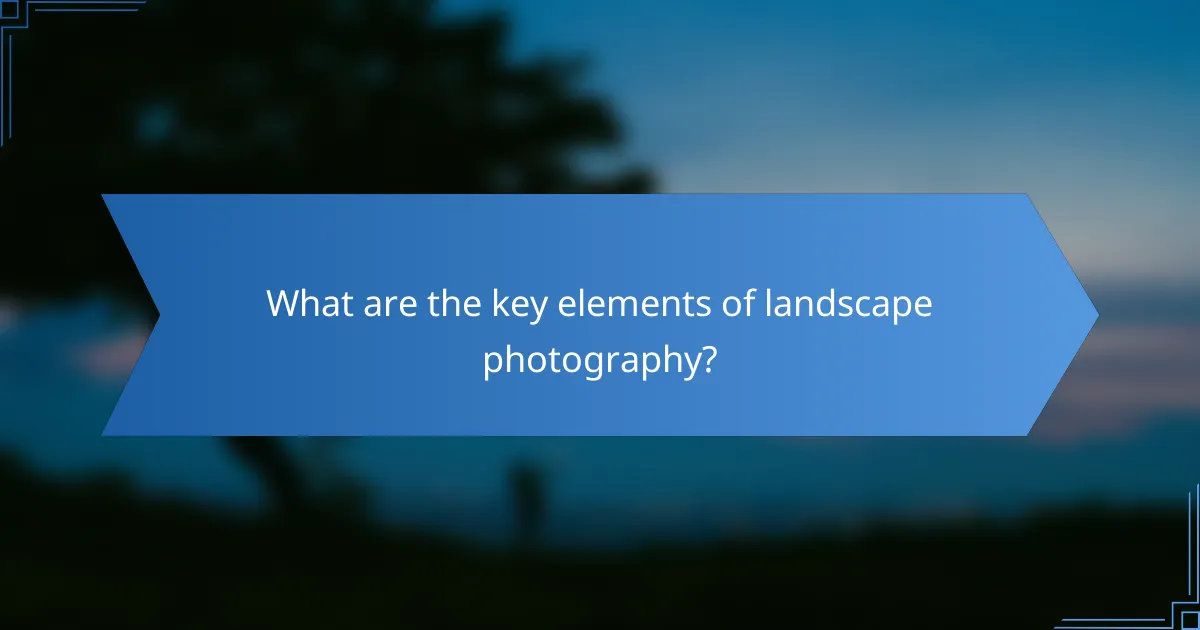
What are the key elements of landscape photography?
Key elements of landscape photography include composition, lighting, subject matter, and depth of field. Composition involves arranging elements to create balance and interest. Lighting, especially golden hour, enhances colors and textures. Subject matter can range from mountains to urban landscapes. Depth of field controls the focus, influencing the image’s mood. Each element contributes to capturing the essence of natural beauty and cultural heritage.
How does composition influence landscape photography?
Composition significantly influences landscape photography by determining how elements are arranged within the frame. Effective composition guides the viewer’s eye, creates balance, and highlights the natural beauty and cultural heritage of the landscape. Techniques such as the rule of thirds, leading lines, and framing enhance visual interest and depth. For example, placing a focal point off-center can create a more dynamic image. Additionally, understanding light and shadows can further enhance the composition, adding mood and emotion to the photograph.
Why is lighting critical in capturing landscapes?
Lighting is critical in capturing landscapes because it enhances colors, shapes, and textures. The quality of light influences mood and atmosphere, creating depth and dimension. For example, golden hour light softens shadows and enriches hues, making scenes more visually appealing. Proper lighting techniques can reveal unique attributes of natural features, showcasing their beauty effectively.
Which camera settings are essential for landscape photography?
Essential camera settings for landscape photography include aperture, shutter speed, ISO, and white balance. A small aperture (high f-stop) enhances depth of field, ensuring sharpness across the scene. A slower shutter speed captures movement, like flowing water, while a low ISO reduces noise in bright conditions. Adjusting white balance ensures accurate color representation, especially during sunrise or sunset.
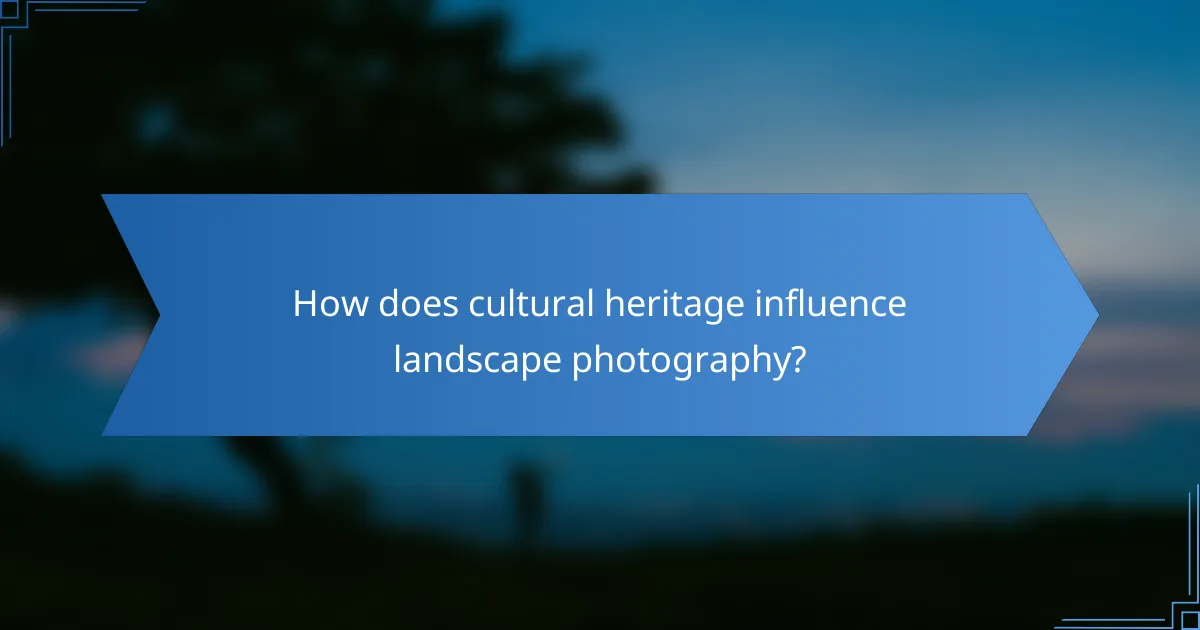
How does cultural heritage influence landscape photography?
Cultural heritage significantly influences landscape photography by shaping the themes, subjects, and aesthetics captured. Photographers often incorporate cultural elements, such as historical landmarks and traditional practices, into their work. This creates a narrative that connects natural beauty with human history.
The interplay between culture and landscape enhances the emotional resonance of photographs. For instance, capturing a sacred site within a natural setting emphasizes its significance, inviting viewers to appreciate both the environment and its cultural context.
Additionally, regional traditions inform the techniques and styles used in landscape photography. Different cultures may prioritize specific elements, such as color palettes or compositional rules, reflecting their unique perspectives and values.
Ultimately, cultural heritage enriches landscape photography, providing depth and meaning to the portrayal of nature. This fusion encourages a greater appreciation for both the landscape and the history it embodies.
What are the unique landscape photography styles across different cultures?
Landscape photography styles vary significantly across cultures, reflecting unique perspectives on nature. For instance, Japanese landscape photography emphasizes simplicity and tranquility, often featuring minimalist compositions. In contrast, Western styles may focus on grandeur and dramatic lighting, showcasing vast landscapes. Indigenous cultures often incorporate spiritual elements, highlighting the connection between land and identity. African landscape photography frequently captures vibrant colors and dynamic wildlife, emphasizing the richness of the environment. Each cultural approach offers distinct attributes that enhance the appreciation of natural beauty and heritage.
How can cultural narratives be conveyed through landscape images?
Landscape photography conveys cultural narratives by capturing the relationship between people and their environment. This visual storytelling reflects traditions, values, and historical contexts. Each image can represent unique cultural practices tied to specific landscapes, showcasing how communities interact with nature. For instance, a photograph of terraced rice fields illustrates agricultural heritage, while images of sacred sites highlight spiritual significance. Through composition, color, and subject matter, photographers can evoke emotions and provoke thought, making landscapes powerful vehicles for cultural expression.
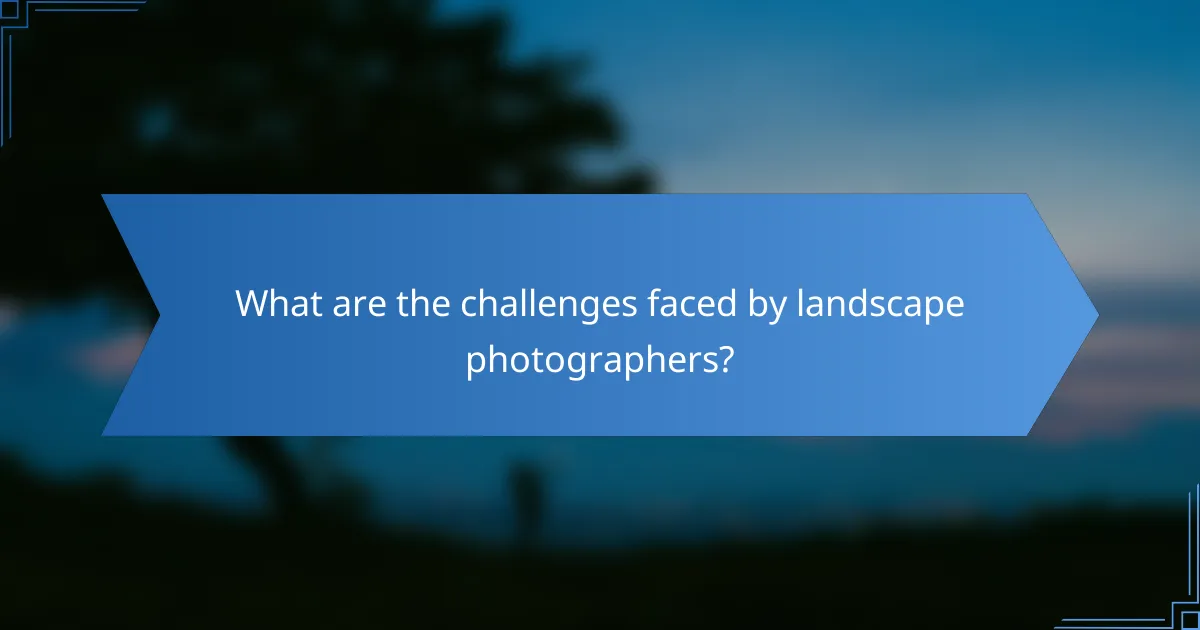
What are the challenges faced by landscape photographers?
Landscape photographers face several challenges, including unpredictable weather, difficult terrain, and the need for extensive planning. Weather can change rapidly, impacting lighting and conditions. Terrain may be challenging to navigate, requiring physical endurance. Planning is essential for capturing the right moment, often involving early mornings or late evenings. Additionally, photographers must consider composition and the presence of unwanted elements in their frames. These factors can significantly affect the outcome of their work.
How do weather conditions affect landscape photography?
Weather conditions significantly influence landscape photography by affecting lighting, mood, and visibility. For example, overcast skies can create soft, diffused light that enhances colors and textures. Conversely, bright sunlight can produce harsh shadows and high contrast, altering the scene’s appearance. Seasonal changes, such as autumn foliage or winter snow, provide unique attributes that can transform landscapes. Additionally, weather phenomena like fog or rain can add dramatic effects, creating a rare atmosphere that captures viewer attention. Understanding these elements helps photographers select optimal conditions for showcasing natural beauty and cultural heritage.
What are common technical issues in landscape photography?
Common technical issues in landscape photography include poor lighting, focus problems, lens distortion, and composition challenges. These factors can significantly affect the quality of images.
Poor lighting often results in underexposed or overexposed photos, making it hard to capture details. Focus problems may lead to blurred images, especially in expansive landscapes where depth of field is crucial. Lens distortion can create unwanted effects, particularly in wide-angle shots. Lastly, composition challenges can result in unbalanced images that fail to engage viewers.
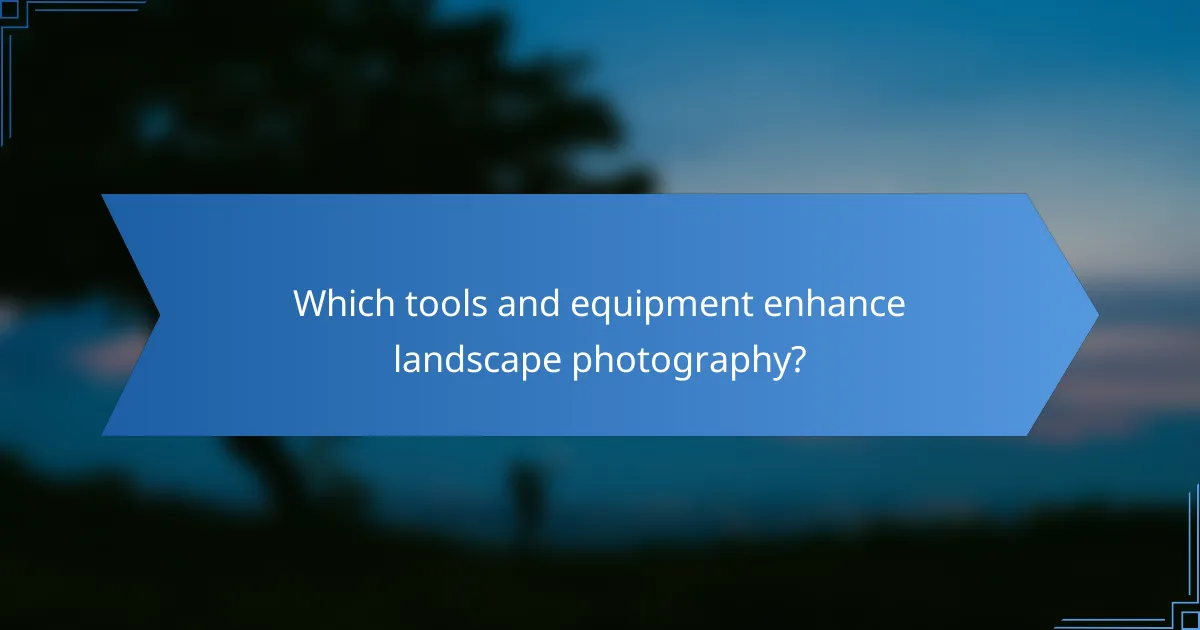
Which tools and equipment enhance landscape photography?
A variety of tools and equipment enhance landscape photography, improving image quality and creative possibilities. Essential items include a sturdy tripod for stability, a wide-angle lens for expansive views, and a polarizing filter to reduce glare.
Additionally, a remote shutter release allows for long exposure shots without camera shake. A lens cleaning kit ensures clarity, while a sturdy camera bag protects gear during outdoor adventures. Investing in these tools can significantly elevate the landscape photography experience.
What role do tripods play in achieving stability?
Tripods are essential for achieving stability in landscape photography. They eliminate camera shake, allowing for sharp images even in low light or with slow shutter speeds. A sturdy tripod supports various camera weights, accommodating different setups. Additionally, tripods enable precise framing and composition, which is crucial for capturing natural beauty and cultural heritage effectively.
How can filters improve landscape images?
Filters enhance landscape images by improving color saturation, contrast, and clarity. They help manage light conditions and reduce glare, resulting in more vibrant and detailed photographs. For example, polarizing filters minimize reflections on water surfaces and enhance the blue of the sky. Neutral density filters allow longer exposures, creating smooth water effects and softening clouds. These tools enable photographers to showcase the natural beauty and cultural heritage of landscapes more effectively.
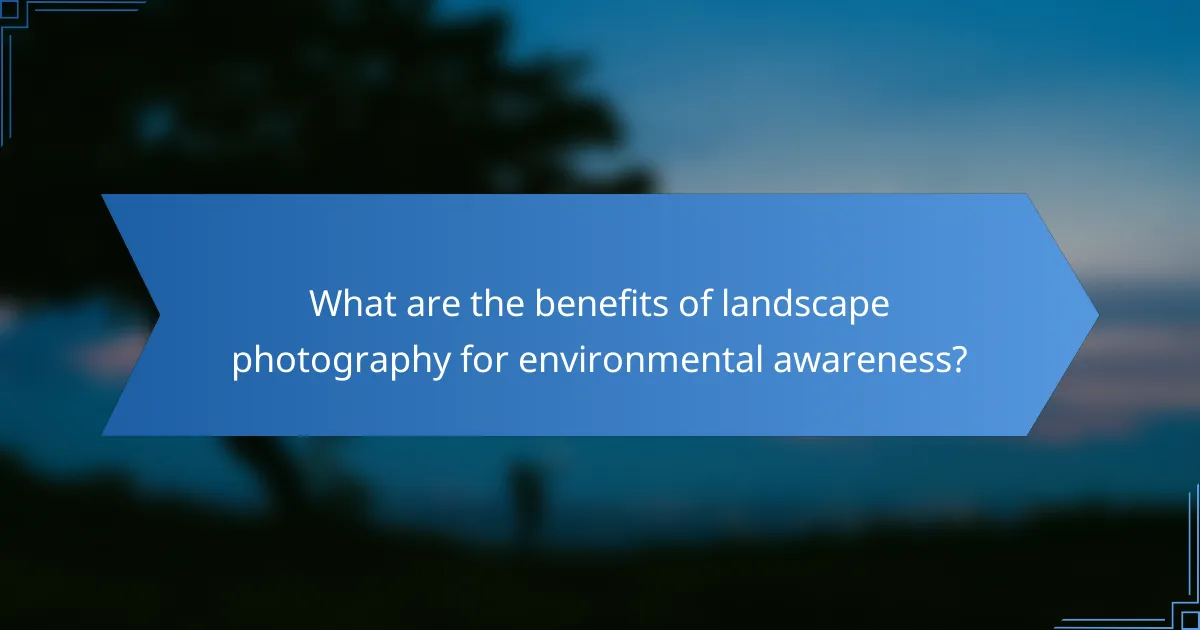
What are the benefits of landscape photography for environmental awareness?
Landscape photography enhances environmental awareness by showcasing the beauty of nature and highlighting the need for conservation. It captures stunning visuals that evoke emotional connections, inspiring viewers to appreciate and protect the environment. Additionally, it documents changes in landscapes, raising awareness of climate change and habitat loss. This art form also promotes cultural heritage, connecting communities to their natural surroundings and fostering a sense of responsibility towards the planet. By sharing these images, photographers can influence public perception and encourage sustainable practices.
How does landscape photography promote conservation efforts?
Landscape photography promotes conservation efforts by highlighting the beauty of nature and raising awareness about environmental issues. Captivating images inspire viewers to appreciate and protect natural landscapes. Furthermore, these photographs can be used in campaigns that advocate for the preservation of ecosystems and cultural heritage sites. By showcasing the impact of human activity on landscapes, photographers can motivate action and support for conservation initiatives. Engaging storytelling through visuals connects audiences emotionally, fostering a sense of responsibility towards the environment.
What impact does landscape photography have on public perception of nature?
Landscape photography positively influences public perception of nature by highlighting its beauty and importance. It fosters appreciation for natural landscapes, encouraging conservation efforts. Stunning imagery can evoke emotional responses, making viewers more aware of environmental issues. This visual representation serves as a bridge between culture and nature, reinforcing the idea that preserving landscapes is vital for future generations. Additionally, landscape photography can inspire tourism, driving economic benefits while promoting environmental awareness.
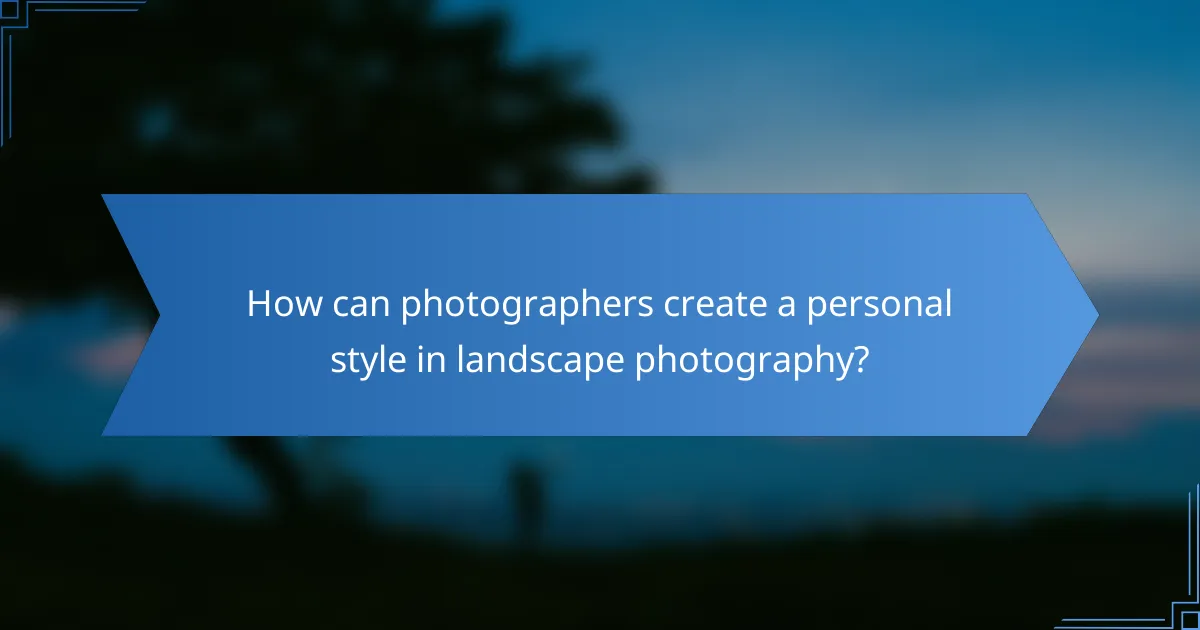
How can photographers create a personal style in landscape photography?
Photographers can create a personal style in landscape photography by developing a unique vision and consistent techniques. They should focus on specific themes, utilize distinctive post-processing styles, and experiment with composition.
Identifying a signature color palette can enhance recognition. Engaging with the environment deeply fosters a connection that reflects in their work. Regularly reviewing and refining their portfolio helps maintain a cohesive style.
What techniques can be used to develop a unique perspective?
To develop a unique perspective in landscape photography, focus on personal storytelling, experimentation with techniques, and the exploration of lesser-known locations.
Utilize storytelling by capturing scenes that evoke emotions tied to cultural heritage, emphasizing the connection between nature and human experience. Experiment with various techniques, such as long exposures and unique angles, to create distinctive images.
Explore lesser-known locations to showcase natural beauty that is often overlooked, providing fresh perspectives that differentiate your work from mainstream photography.
How does post-processing contribute to individual style?
Post-processing enhances individual style in landscape photography by allowing photographers to refine their vision and express personal creativity. This stage involves adjusting colors, contrast, and composition to align with the photographer’s aesthetic.
Through techniques such as selective editing and tone mapping, photographers can emphasize unique attributes of landscapes, showcasing their cultural heritage. For example, enhancing the vibrancy of a sunset can evoke emotions tied to a specific location.
Moreover, post-processing enables the integration of rare elements, like unique weather conditions or seasonal changes, into the final image. This attention to detail can transform a standard photograph into a compelling narrative that reflects the photographer’s individual style.
Ultimately, post-processing is vital for photographers seeking to distinguish their work and convey a deeper connection to the natural beauty and cultural significance of their subjects.
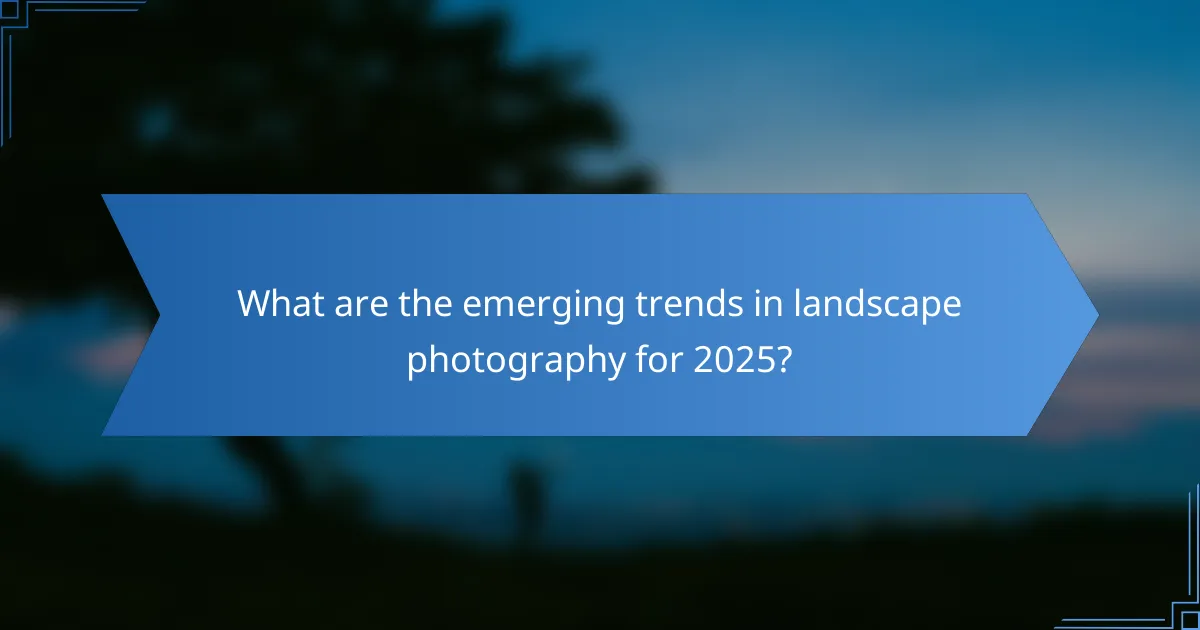
What are the emerging trends in landscape photography for 2025?
Emerging trends in landscape photography for 2025 include increased use of drone technology, focus on sustainable practices, and integration of augmented reality. Photographers will leverage drones to capture unique perspectives, showcasing landscapes from above. Sustainable practices will emphasize minimal environmental impact, aligning with global conservation efforts. Augmented reality will enhance viewer engagement by allowing interactive experiences with images. These trends reflect the evolving relationship between technology, nature, and cultural heritage in photography.
How is technology shaping the future of landscape photography?
Technology is revolutionizing landscape photography by enhancing image quality and accessibility. Advanced cameras and drones allow photographers to capture stunning visuals from unique perspectives. Software improvements in editing tools facilitate greater creativity and precision in post-processing. Additionally, social media platforms provide wider exposure, enabling photographers to share their work globally and connect with audiences.
Which new platforms are popular for sharing landscape photography?
Instagram, Pinterest, and 500px are currently popular platforms for sharing landscape photography. These platforms allow photographers to showcase their work to a global audience, fostering community engagement. Instagram’s visual-centric approach and hashtags enhance discoverability, while Pinterest serves as a source of inspiration through curated boards. 500px offers a more professional environment, focusing on high-quality images and networking opportunities among photographers.
What are the best practices for capturing and sharing landscape photography?
To capture and share landscape photography effectively, focus on composition, lighting, and storytelling. Use a tripod for stability, shoot during golden hours for optimal lighting, and consider including cultural elements for depth.
1. Plan your composition by using leading lines and the rule of thirds.
2. Experiment with different angles and perspectives to add interest.
3. Edit your photos to enhance colors and details while maintaining authenticity.
4. Share on platforms like Instagram or photography websites to reach a wider audience.
Engaging captions and tags can help convey the story behind each image.